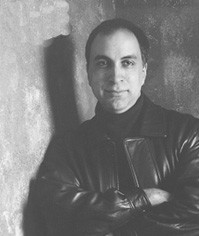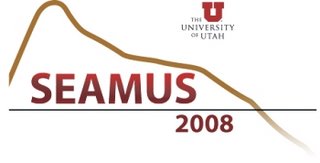
Composer Anthony Cornicello (born in Brooklyn, New York, 1964) writes music that blurs distinctions between performers and electronics, timbre and harmony, composition and improvisation, and explores the boundaries of what may be considered post-classical concert music. His music is vibrant and visceral, full of rhythmic energy and harmonic sophistication, and his forays into live electronics have led to exciting combinations of instruments and processed sound. Cornicello’s background as a jazz pianist is evident not only in the rhythmic activity of his music, but also in his constant investigation of the rich sonorities available from a variety of instruments.
He has been commissioned to write music for the Scorchio Electric String Quartet, ModernWorks! (funding from Meet the Composer/ Commissioning Music USA), the Auros Group for New Music, the Prism Saxophone Quartet, the New York New Music Ensemble, David Holzman, the Group for Contemporary Music, and the InterEnsemble of Padova, Italy. His work has also been featured on the Guggenheim Museum’s “Works and Process” series. Cornicello’s works have also been performed by the Chicago Civic Symphony, Parnassus, ALEA III, Composers Concordance, Madeleine Shapiro, Robert Black, among many other outstanding groups and solo performers. His music has been presented as part of the Darmstadt International Festival of New Music as well as the June in Buffalo Festival.
Cornicello’s Second String Quartet has been recorded by the Atlantic String Quartet; the Second Sonata for Piano by David Holzman (Centaur). More recently, his Post-Modern Waltz was recorded by Eric Moe for Albany Records. A portrait CD of Cornicello’s works is scheduled for 2006 release on Albany Records.
As a performer, he has conducted or played piano in his own works on numerous occasions. While a graduate student at Rutgers, he formed and directed the Janus Ensemble, a group dedicated to contemporary music. More recently, Cornicello has begun performing on the laptop, using a variety of interfaces and the Max/MSP program. Those performances, mostly with EEE!, have had a notable impact on his music, as EEE!’s music ranges from hip-hop to experimental noise. EEE! is based at Eastern Connecticut State University, where Cornicello is an Associate Professor and Director of the Electronic Music Lab.
Cornicello received the Ph.D. from Brandeis University, where he studied with David Rakowski, Eric Chasalow, and Martin Boykan. His teachers also include Charles Wuorinen, Gérard Grisey, and Richard Beirach.
His current fields of interest include developing unusual interfaces for live computer music performances, as well as continuing to investigate resonance and spatialization. His recent and current projects (mostly for string instruments and electronics) have been exploring the latter two, and the series of experimental works ReZenant Garden, performed by EEE! have operated on all three areas of interest. Future projects will include works for instrumental groups or soloists and electronics, as well as turntablists.
Cornicello's works are published by C.F. Peters Corporation and APNM, and he is a member of BMI.
|
|
|
|
|
|

Saturday, April 12, 2008
SEAMUS 2008, part 1

This past week, I had the pleasure of attending the SEAMUS 2008 National Conference in Salt Lake City. To say the least, it was an interesting event. Over the years, I've been to conferences of all sorts. Most of the time, I find that there are a few pieces that I'd like to hear again, some that don't necessarily retain my interest, and many pieces that I don't want to hear again. SEAMUS 2008 was quite the opposite: there were many pieces that captivated me, and only a few things that I'd rather not hear again.
In total, there were 13 concerts and 4 paper sessions, presented from Thursday April 3rd to Saturday, April 5. I was only able to get to the concerts and papers up to Saturday morning. I'd like to talk about the concerts and papers that left a good impression upon me.
I'm going to start with the concerts. The first concert had two wonderful works: Veiled Resonance by Elainie Lillios and Thomas Royal's Soft Strings of a Cold Dead Image. Veiled Resonance was set for soprano saxophone (Stephen Duke, an amazing saxophonist) and interactive electronics, with some imaginative linking between the two sound worlds. From what I recall, there wasn't a clear saxophone note for almost 2/3 of the piece - instead, the player used a variety of means to get sounds out of his instrument. Yet, I didn't notice this until afterwards, and it certainly didn't bother me. Thomas Royal's piece was for solo voice and electronics, dramatically performed by the composer. Texts were stretched and mutated by the computer, and sudden moments of clarity only added to the tension of the work.
Two standouts from Concert 2 include McGregor Boyle's Midway Inlet, played by Gerry Errante, and Julian Peterson's A Brief Respite from Fear, for game controller and saxophone (Ryan Bledsoe). Midway Inlet had a nice blend of sounds from the clarinet and pre-recorded material taken from Pawleys Island in South Carolina, as well as the integration of Gregorian Chant into the clarinet writing. Peterson's work was written as a duo for sax and live sound triggering. I'm not sure if there was any improvisation in the work, but the program notes mention that the video game controller is used to trigger granular textures and sequences programmed in csound. I've got to say, the piece looked cool.
This brings up two points about the conference. One, there was a huge variety of techniques being used. Contrary to what I've been told, csound is still being widely used. There were quite a number of tape pieces, and not just by older composers used to working in that medium. There was also a large contingent of SuperCollider users, some even adamant about its superiority to Max. I'm a Max guy.
The other issue has to do with the annual SEAMUS recording. The pieces are chosen from the pieces presented at the conference. I think the next volume to be released will also have a DVD to show video works. However, the works on the DVD are presentations of those pieces conceived of for the video media - that is, a short film with a soundtrack. I'm wondering if it would be possible to start including concert footage. Some of the pieces in the SEAMUS conference will not translate well to an audio-only format. There's a certain element of intrigue when watching a good performer working with some of this material. The pieces with unusual interfaces and odd controllers, often resulting in an exquisite ballet, will yield a much more positive response from a viewer, as opposed to listening to a traditional CD. Sure, the piece will sound the same, but there is something about seeing how the sounds were generated that aids in the appreciation of the work.
More next time.
posted by Anthony Cornicello
|
| |



